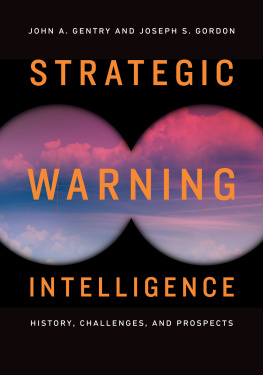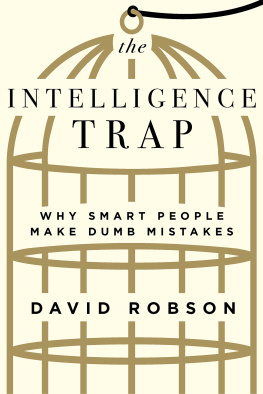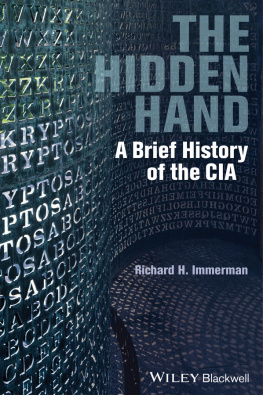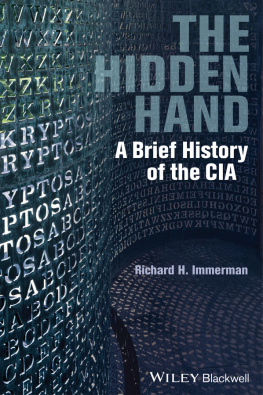Constructing Cassandra
REFRAMING INTELLIGENCE FAILURE AT THE CIA, 19472001
Milo Jones and Philippe Silberzahn
Stanford Security Studies
An Imprint of Stanford University Press
Stanford, California
Stanford University Press
Stanford, California
2013 by the Board of Trustees of the Leland Stanford Junior University.
All rights reserved.
No part of this book may be reproduced or transmitted in any form or by any means, electronic or mechanical, including photocopying and recording, or in any information storage or retrieval system without the prior written permission of Stanford University Press.
Special discounts for bulk quantities of Stanford Security Studies are available to corporations, professional associations, and other organizations. For details and discount information, contact the special sales department of Stanford University Press.
Tel: (650) 736-1782, Fax: (650) 736-1784
Printed in the United States of America on acid-free, archival-quality paper
Library of Congress Cataloging-in-Publication Data
Jones, Milo, author.
Constructing Cassandra : reframing intelligence failure at the CIA, 19472001 / Milo Jones and Philippe Silberzahn.
pages cm
Includes bibliographical references and index.
ISBN 978-0-8047-8580-8 (cloth : alk. paper)
1. United States. Central Intelligence AgencyHistory. 2. Intelligence serviceUnited StatesHistory. I. Silberzahn, Philippe, author. II. Title.
JK468.I6J7 2013
327.1273009'045dc23
2013010527
Typeset by Thompson Type in 10/14 Minion
ISBN: 978-0-8047-8715-4 (electronic)
CONTENTS
PREFACE AND ACKNOWLEDGMENTS
THIS BOOK IS THE RESULT of a unique collaboration between Milo Jones (on whose research it is based) and Philippe Silberzahn.
Both Milo and Philippe would like to thank (in alphabetical order): Dr. Albena Azmanoza, Fiona Buckland, Ignacio Corrachano, Dr. Christopher Daase, Daniel Gastel, Jeremy Ghez, A. Edward Gottesman, Dr. Kent Grayson, Lisel Hintz, the late Alan P. Jones Jr., Edith H. Jones, Dr. Elizabeth B. Jones, Frances C. Jones, Dr. Amanda Klekowski von Koppenfels, Bernhard Kerres, Dr. Mitchell Leimon, the late Dr. William Melczer, Ewa Moncure, Dr. Philippe Monin, Dr. Michael Palo, Prof. Richard Portes, Alastair Ross, Dr. Blair A. Ruble, Dr. Eitan Shamir, Dr. Jamie Shea, Nassim Nicholas Taleb, Dr. Mark Teeter, and Dr. Jarrod Wiener; they also thank Allen Thomson, the late Christine Zummer, and other CIA employees (past and present) and members of the AFIO who wish to remain anonymous.
Milo dedicates this book to his wife Ewa, daughter Emily, and to U.S. Marines, past, present and future: Semper Fi.
Philippe dedicates this book to his wife Chittima, daughter Margaux, and son Antoine.
ABBREVIATIONS
COSPO: Community Open Source Program Office
CTC: Counterterrorism center (CIA)
DCI: Director of Central Intelligence, head of the CIA
DDCI: Deputy Director of Central Intelligence
DI: Directorate of Intelligence
DIA: Defense Intelligence Agency
DO: Directorate of Operations
DOD: Department of Defense
HUMINT: Human Intelligence
IC: Intelligence Community
IMINT: Image Intelligence
INR: Bureau of Intelligence and Research (State Department)
MASINT: Measurement and Signature Intelligence
NIC: National Intelligence Council
NIE: National Intelligence Estimate
NSC: National Security Council
OIG: Office of Inspector General (CIA)
OSINT: Open-source Intelligence
SIGINT: Signal Intelligence
SNIE: Special National Intelligence Estimate
SOVA: Office of Soviet Analysis (CIA)
INTRODUCTION
OVERTURE
On September 22, 1947, in response to the rapidly escalating Cold War, U.S. President Harry Truman created the Central Intelligence Agency (CIA). In the dry language of the National Security Act of 1947, the core responsibility of the agency was to correlate and evaluate the intelligence relating to national security, and to provide for the appropriate dissemination of such intelligence within the government.obviously a remit to give strategic warning, not to thwart further attacks by the Japanese Imperial Navy. In short, the CIA was charged with preventing strategic surprises to the United States in the realm of foreign affairs. The agencys multiple failures to meet that demanding chargeat tremendous costare the subject of this book.
In 1962, for example, the CIAs estimate of the likelihood that the Soviets would place nuclear missiles in Cuba proved completely wrong. The agencys misjudgment was not simply a question, as chief analyst Sherman Kent put it, of coming down on the wrong side in a single intelligence estimate.about the probability of the USSR positioning missiles in Cuba, warnings provided months before the rockets were discovered.
Sixteen years later, in 1978, Iran was a key U.S. ally. Samuel Huntington was a staff member of President Carters National Security Council (NSC). In September of that year, when the Iranian Army shot and killed peaceful demonstrators in the Jaleh Square massacre, indicators of a revolutionary climate soared. Huntington asked the CIA for an assessment of a post-shah Iran. In response, the agency sent him a discussion of the Iranian constitution and the chances of creating a regency council for a transition within the Pahlavi dynasty, For several years before the Islamic Revolution, however, businessmen had noted that Iranians were sending record amounts of money out of the country. Private business risk management services were also questioning the stability of Iran. Moreover, in the spring of 1978, the French newspaper Le Monde ran a series of articles detailing grave trouble for the shah. French and Israeli intelligence also detected Irans revolutionary rumblings well in advance. Nevertheless, the agency was caught off guard.
Eleven years later, in 1989, the CIAs original raison dtre, the Soviet empire, started collapsing. According to former DCIdirector of central intelligence, as the head of the CIA is calledStansfield Turner, the CIAs corporate view missed this event by a mile.economy and that the centrifugal forces of nationalism in Soviet republics were increasing.
Some ten years later, the head of the CIAs bin Ladin unit, Michael Scheuer, struggled to raise the alarm within the CIA about the danger posed by al Qaida.
In short, by September 12, 2001, fifty-four years and countless billions of dollars after it was founded, it was clear that the CIA would not be a cure-all for Americas Pearl Harbor problem.
A NEW APPROACH TO AN OLD QUESTION
This book takes a new approach to an old question: How do strategic surprises occur? More explicitly, it offers a new way of understanding strategic surprises experienced by the United States between 1947 and 2001 by looking at the agency charged with preventing such surprises, the CIA.
The word understand as opposed to explain is carefully chosen in the previous sentence. There is a tradition in the so-called social sciences as opposed to explanation. As the following argument develops, it will become clear that this distinction is more than linguistic hairsplitting. In fact, it goes straight to the heart of the epistemology of this bookwhat can we know about surprise and intelligence analysis, how we can know it, and what are the implications of our knowledge and our ignorance?
It is important to emphasize that this book is not a gotcha-style attack on the dedicated men and women of the agency. It does not underestimate the difficulty of their task, and it tries to avoid hindsight bias. Instead, it is an attempt by two outsiders to take a fresh approach to understanding how the CIA repeatedly failed to provide effective strategic warning over this period and to make these intelligence failures informative in order to improve analysis. Toward that end it examines the four strategic surprises already listed, the CIA itself, and Cassandrasthose from both inside and outside the agency whose warnings were ignored.
Next page









